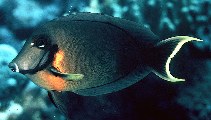| Family: |
Acanthuridae (Surgeonfishes, tangs, unicornfishes), subfamily: Acanthurinae |
| Max. size: |
29 cm TL (male/unsexed) |
| Environment: |
reef-associated; marine; depth range 0 - 60 m |
| Distribution: |
Indo-Pacific: Seychelles to the Marquesas and Tuamoto islands, north to southern Japan, south to the Great Barrier Reef and New Caledonia. Replaced by Acanthurus trisits from the Maldives and Chagos Islands to Bali (Ref. 37816). |
| Diagnosis: |
Dorsal spines (total): 8-8; Dorsal soft rays (total): 27-30; Anal spines: 3-3; Anal soft rays: 24-28. Purplish black in color; an orange diffused patch at edge of gill opening, just above pectoral fin base; a broad black band from upper end of gill opening to margin of gill cover down to isthmus; caudal spine socket with a narrow black margin. Blackish lips; a trace of orange behind eye; a white line under chin extending slightly above rictus. Gill rakers on anterior row 23-26; on posterior row 25-27. Juveniles can exhibit 3 different color patterns mimicking Centropyge species. Caudal fin rounded in juveniles.
Description: Characterized further by having length of caudal spine about 2.5-4.5 in head lengh; greatest depth of body 1.8-2.0 in SL (Ref. 90102). |
| Biology: |
Occurs in lagoon and seaward reefs; prefers areas of mixed coral, rock, or sand at the base of reefs or ledges, Ref. 48637. Also on silty reefs (Ref. 9710). Found singly (Ref. 9710). Juveniles mimic Centropyge spp. (in Guam, juveniles mimic C. flavissimus but in Palau where this species is absent, they mimic C. vrolikii), Ref. 48637. Presence of a venom gland could not be determined despite the presence of distinct anterolateral grooves; this may be due to the loss of venom glands in adults (Ref. 57406). Feeds on algae (Ref. 89972). Minimum depth reported taken from Ref. 128797. |
| IUCN Red List Status: |
Least Concern (LC); Date assessed: 04 May 2010 Ref. (130435)
|
| Threat to humans: |
harmless |
Source and more info: www.fishbase.org. For personal, classroom, and other internal use only. Not for publication.

